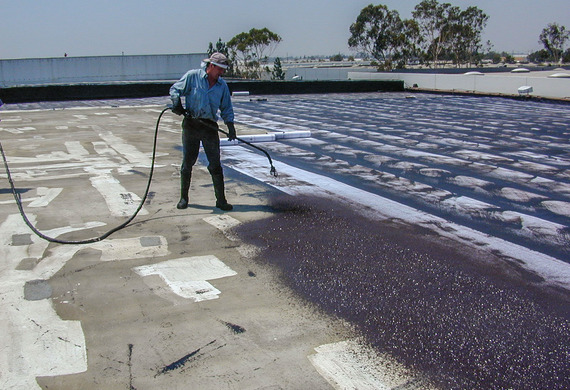
MORE GREAT TIPS FOR APPLYING ASPHALT EMULSION ROOF COATING
Our goal at Western Colloid is to help you and your crew be as efficient, clean, and safe as possible. As we build our FARR Best Practices Program, we will continue to share these terrific tips. Part of most of our specifications are started with Asphalt Emulsion as the first coat. Below are some recommendations for you.
Choosing the Right Amount of Emulsion
First, figure out which specification fits your customer’s budget and desired warranty. For example, how much asphalt emulsion will you need? In general, we recommend a minimum of six gallons per hundred square feet. However, many roofs need 12 gallons, and gravel roofs may take much more. That might sound like a lot, but the good news is that it’s actually economical.
Correct Container Size
If you are working on a large roof, order material in the largest size container possible. Our recommended pump can spray an average of about 12 up to 17 gallons per minute. There is nothing worse than getting into a rhythm of spraying emulsion and rolling out polyester when the drum runs out of emulsion. You could spend most of your time replacing the container if you aren’t choosing one that’s large enough. With the right staging area, container, pump, and hose length, you can leave everything on the ground and pump the asphalt emulsion up to the roof.
Find our FARR Best Practices Videos and Podcasts Here.
Keep An Eye On The Weather
You should know that any roof coating needs the right conditions to cure once it’s applied. Keep an eye on the weather when you pick a day to apply it. Our products should not be applied at temperatures less than 55 degrees AND RISING. If the water in the coating freezes, it won’t cure properly and risks cracking. Also, make sure there is no rain in the forecast so the coating has time to dry.
Clean & Repair Before Application
Be sure to clean your roof deck, removing any loose material, dirt, and debris. For example, use a stiff broom or a pressure washer for tough dirt. Next, remove oils and greases. Be sure to remove any soap you use so the asphalt coating will adhere properly.
Furthermore, even though a good quality asphalt emulsion will fill in many small voids, make sure that larger ones are patched well. In addition, be sure to allow time for these repairs to cure before applying your coating. Repair and replace any damaged flashing and address all penetrations.
Keep Clean
One of the biggest issues faced with asphalt emulsion is the possibility of tracking it in the building, creating more cleanup and safety hazards. Keep your job clean and safe with these tips:
- Wrap ladder rungs with non-slip tape. When the job is done, just peel off the tape for easy cleanup.
- Wear rubber boots and coveralls over your clothes. When you need to leave the roof, take them off and leave them on the roof so no tracks are left in the building or parking lots.
- Use commercial-grade shrink wrap instead of painter’s tape to cover HVAC units, skylights, and other large equipment. Lightweight paper can easily blow off in the wind, leaving units exposed and wasting time and money on recovering the units.
- Make sure everyone knows to NOT walk through the emulsion while rolling out polyester. Not only will your shoes get covered and track sticky asphalt over the rest of the roof (including that just smoothed out polyester), but you’ll leave marks that can result in poor adhesion and no waterproofing in those spots.
- Keep your asphalt emulsion and acrylic equipment separate.
- If you need to do minor clean-up, try an orange cleaner or mineral spirits. We do not recommend you use gasoline.
Protect Your Equipment
Worried about how to protect the tools and equipment from drying up overnight? Leave items that have touched the asphalt emulsion, such as brooms, hoses, wands, and rubber gloves, in a vat of water overnight, or in a trash bag. Have plugs on hand for the hoses. It will keep the asphalt from hardening and potentially ruining your hand tools and equipment.
Protect The Building
Another expert tip is to include a protective slip over the hose carrying the emulsion up the side of the building from the pump to the roof. That way, if the hose blows out, the building, parking lot, and cars below won’t be covered in asphalt emulsion. Types of slips include any flexible tubing or even a fire hose.
Use the Right Equipment for the Job
When using the right pump, hose, nozzle, and material packaging, you can cover up to 200 feet per minute! In addition, this high production rate raises your bottom line since you’ll finish faster.
Make sure you choose a pump with the right pressure. For example, a pump with low pressure and high volume works best. Always use the properly rated hose and wand for your pumps PSI. And don’t confuse asphalt emulsion spray nozzles with an acrylic coating spray nozzle—they’re different. However, you shouldn’t be intimidated by the equipment needed. Asphalt emulsion roof coatings are easy to install. For more details, watch this video.
Contact us anytime to speak with one our technical team for more tips for applying asphalt emulsion-based coating systems or any of our systems. We are here to help you.

